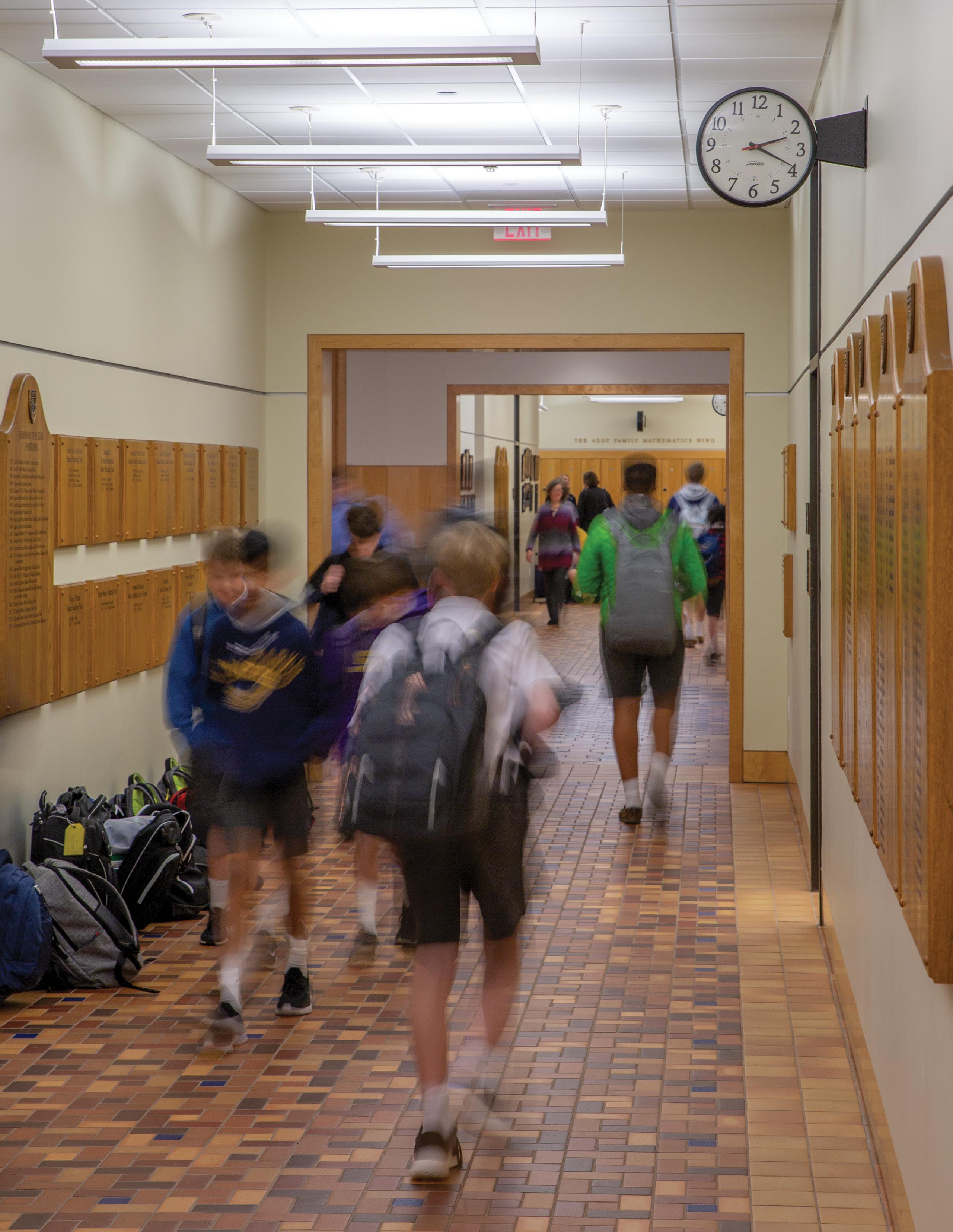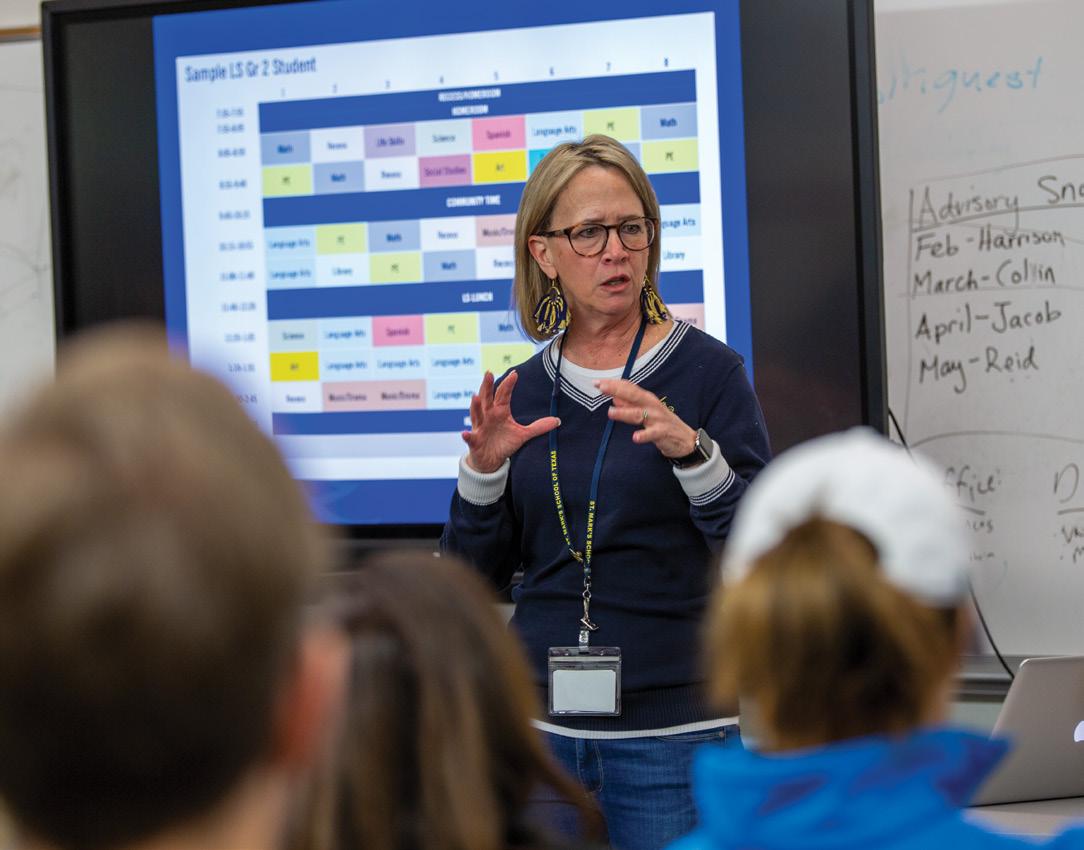
5 minute read
The New St. Mark’s Schedule

The average Marksman has a lot on his mind: homework,
labs, class meetings, club meetings, and after-school practices, just to name a few. St. Mark’s teachers are no less busy, constantly thinking about lesson plans, classroom activities, assignment and test schedules, co-curricular duties, and so much more. Added together, these details comprise a large portion of the St. Mark’s experience. And behind it all, driving
the decisions of students, teachers, and administrators, is something few ever pause to consider: the daily schedule.
(above)
Head of Lower School Sherri Darver discusses the schedule and answers questions during one of the parent information sessions

For any school, the daily schedule is the framework upon which everything is built. The schedule determines how many classes a school can offer, how students will interact with co-curricular activities, how teachers prepare their daily lessons, and the amount of work students complete during and after class. The schedule also reflects a school’s belief in the best way to educate its students. For decades, the St. Mark’s school year has been divided into three trimesters, with each day split into nine periods. And for decades, this schedule has served the School well. But, as the nature of education and our understanding of adolescent minds have evolved over the decades, it became clear that there was untapped potential hidden in the school day. And, as the schedule is so deeply ingrained in daily life on campus, any changes or alterations would have to be made with the most careful consideration.
“We knew that a schedule review was something to which we needed to devote the appropriate time and resources,” said Eugene McDermott Headmaster David W. Dini. “Time is finite, and we have to figure out how to make the most out of every minute we have with the boys each day.”

daily schedule several years ago. The question was simple: How can we make it even better? In 1984, the School made a formal schedule review part of its first strategic plan, Goals for St. Mark’s I, and identified the need to “appoint a group to study the daily schedule.” This continued to be a priority in later iterations. Goals for St. Mark’s III (2002) recommended that the School “regularly review the master schedule to reduce obstacles to a student’s preferred choice of courses and activities.”
In 2017, the latest iteration of the School’s strategic plan, Goals for St. Mark’s IV, elevated the priority of the schedule review and specifically recommended that the School “explore, design, and implement a daily schedule that better addresses the evolving needs of students and faculty.” Goals IV went on to recommend that the School conduct a comprehensive schedule review, investigate new models, and ensure a smooth transition for the community. Later that year, the Reaccreditation Visiting Committee from the Independent School Association of the Southwest applauded St. Mark’s efforts, calling the schedule review “both laudable and necessary.” Their final report “wholeheartedly recommend[ed] careful analysis of the different ways that students, faculty, and staff use structured and unstructured time.”


The Committee visited peer schools, all of which subscribe to different types of schedules. St. Mark’s dedicated several in-service days exclusively to the schedule, holding meetings with the full faculty and then drilling down to the details in department and divisional meetings.
“We worked in cross-departmental and crossdivisional groups and discussed all we do with the boys in a given school day,” said Associate Headmaster John Ashton. “We thought about what we like about the current schedule and what we would like to be able to do that we currently cannot.”
Ultimately, the Schedule Review Committee committed to four guiding principles:
(above) Paul Mlakar shares details of the schedule with faculty members during an in-service day
Same Mission. Greater Possibilities. Over the past few years, St. Mark’s has been hard at work, reviewing and revising the schedule. The School formed a Schedule Review Committee comprising the Headmaster, Division Heads, Department Chairs, and the Director of Academic Information Systems. The Committee partnered with Independent School Management (ISM), a consulting firm that specializes in scheduling. ISM’s President and Senior Consultant Roxanne Higgins visited campus several times, meeting with faculty, students, and administrators to learn how people interacted in the existing schedule and what new opportunities could be possible. Sustain strength and quality of current program Enhance student health and well-being Improve alignment and collaboration opportunities across campus Increase flexibility to better accommodate current and future programs
And, of course, the entire process was guided by the School’s singular mission: teaching Marksmen to thrive.
“This has been a mission-driven process since day one,” said David Dini. “This entire discussion about the daily schedule has continuously rotated back to our mission, how we get better as a school, and how we strengthen the boys’ complete development.”

16 FACULTY MEMBERS
ON THE SCHEDULE STEERING COMMITTEE
62 NUMBER OF MEETINGS
BY THE REVIEW COMMITTEE OVER THE
PAST 3 YEARS
The result of years of research and hundreds of hours of planning and input from community members is a schedule that meets all four of the guiding principles and will provide new possibilities for the education of Marksmen.
With the new schedule ready, the School is moving to the next step laid out in Goals IV: “Ensure a smooth transition for students, faculty, and parents to the daily schedule.” St. Mark’s formally unveiled the new daily schedule in February 2020 and launched a webpage with resources to help parents, students, faculty, and staff understand the changes. Throughout February and March, the School hosted Parent Information Sessions, where division heads walked parents through the new schedule’s features and benefits and fielded questions. Soon after the schedule announcement in February, an editorial in The ReMarker encouraged students to “Embrace the Change,” adding “Change can be hard. We recognize that. But eventually the change will become routine, and when it does, we will all emerge on the other side better off realizing that this change reflects only the best of intention.”
Learn more about the daily schedule by visiting www.smtexas.org/Schedule.
12 NUMBER OF NEW ONE-SEMESTER CLASS OFFERINGS
6NUMBER OF IN-SERVICE
DAYS DEDICATED TO
DISCUSSING NEW SCHEDULE WITH FACULTY


